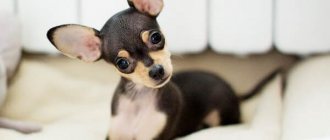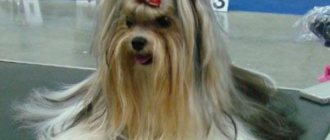According to the breed standard, the Yorkshire Terrier's ears should be small and erect.
But not all puppies, for one reason or another, have their ears raised on time.
And, if the owners of pet-class dogs do not always worry about this, then the owners of promising show puppies are always worried when their pet’s ears do not rise.
And they can be understood: after all, weak ear cartilage in a Yorkie is considered a serious drawback, and if the ears droop, this can even cause the dog to be disqualified for life and excluded from breeding.
How to put ears on a Yorkie - basic methods
To ensure that your Yorkie's ears are in the correct position and there are no kinks in the cartilage, there are several methods. You can massage the cartilage, glue special devices to the ears, or review your pet’s diet. We list all the methods from simple to complex.
Reducing ear weight by trimming hair
Sometimes the mass of thick and dense hair does not allow the thin cartilage in the puppy’s ears to stand up straight. The easiest way to test the likelihood of a guess is to cut off excess hair from the top half of the ear to approximately the middle, without approaching the ear canal.
You can cut off excess hair yourself (with scissors, a pet clipper) or entrust the haircut to a professional groomer.
Yorkie ear massage
Weak and thin ear cartilages can be trained with massage. To do this, you need to take the ears with two fingers, placing your index finger on the inside of the shell and your thumb on the outside.
Using light circular movements, massage the ear from the base of the cartilage tissue to the tips from bottom to top. The movements should be smooth, there is no need to squeeze or tug the Yorkie's ears too much. You should not massage too close to the ear canal.
The best option would be to visit a massage specialist or veterinarian. A professional will explain the nuances of the procedure, control the owner’s movements and give additional recommendations on how to fit the ears of a Yorkshire Terrier.
Several massage sessions a day for two to three weeks will help strengthen the muscle and cartilage tissue of the ears. However, this method does not always work 100%.
Improved nutrition
You can influence cartilage tissue not only from the outside, but also from the inside. Nutritional supplements with chondroprotectors, calcium, and vitamins will deliver the necessary components to the address, which will help ensure that the ears stand up correctly and strengthen the overall health of the pet.
The main thing is not to forget about the rule “too good is also bad.” A rare dog lover without the appropriate skills will be able to correctly calculate how many nutrients a Yorkie needs. A dog menu developed together with a veterinarian will only bring benefits to your pet.
Dog breeders recommend adding gelatin dissolved in water, beef leg jellied meat, or broths with cartilage tissue to the puppy’s diet.
Ear training using tape
Gluing is the best method for training Yorkie ears at home. Suitable for puppies aged 4 – 5 months. When done correctly, the procedure is painless, effective, and usually well accepted by your Yorkie.
"Tube"
Tools:
- Hypoallergenic silk-based patch;
- Dog trimmer;
- Scissors;
- Degreasing lotion;
- Natural vegetable oil at the end of the course.
Duration of one course: 3 days. The procedure can be repeated at intervals of 7 days.
Algorithm for gluing ears:
- Wash the puppy thoroughly, dry and comb the coat;
- Secure the Yorkie with a towel or the assistance of an assistant;
- Remove hair from the outer surface of the ear. The more thoroughly you treat the auricle, the better the patch will stick;
- Gently clean the ear, examining for the absence of diaper rash or inflammation, wipe with lotion;
- Wrap the part of the dog's ear above the ear canal into a loose vertical tube. It is necessary to ensure that there are no kinks in the cartilage, and that the ears themselves are not squeezed;
- Glue the ears with tape around the “tube”;
- Secure both wrapped ears in a vertical position with an elastic band or tape;
- At the end of the course, remove the patch by moistening it with vegetable oil.
By
Regular massage
The massage is designed to strengthen cartilage and muscle fibers. With regular stimulation of the ears, blood in this area begins to circulate more actively, delivering minerals and nutrients to the tissues.
The procedure must be carried out with great care. If applied incorrectly, the likelihood of ear damage increases.
The procedure is performed as follows:
- The index finger is carefully placed into the auricle at a shallow depth.
- The thumb is placed on the outside of the ear.
- Stimulation is carried out in a circular motion with a smooth stretching of the ears in the direction from the base to the end.
Important! It is better to entrust the first session to an experienced specialist.
2-3 sessions are required per day. Then the effectiveness of the procedure will increase. But you need to know that massage does not provide a 100% guarantee of straightening cartilage.
Veterinarian recommendations
Veterinarians believe that it is not worth gluing ears unless absolutely necessary. If your dog's teeth are changing or growing, then at this moment the ears may not stand up. When the moment of changing teeth passes, the ears will return to their usual position. Teeth change during the first year, but this largely depends on the individual characteristics of the Yorkie’s body.
During the formation of ear cartilage, you should be very careful when petting your dog in this area. To prevent excess hair from pulling on the ears, it is recommended to promptly take your dog for a professional haircut or trim the length at home
Veterinarians strongly recommend not gluing ears for more than a week. If the ears last longer and during this time the situation has not improved, then you need to look for reasons elsewhere. Perhaps your Yorkie simply does not have enough calcium in the body, so you should feed the animal fully and give foods with calcium. For example, cottage cheese. Also, for puppies that need calcium and other minerals, you can purchase various supplements that replenish this element.
Why don't they get up
Regardless of the baby's gender, by the age of four months their ears should already be raised. Sometimes this happens after changing teeth.
But if four months have already passed, the teeth have changed, and the ears are still not standing, it is necessary to first determine the cause of this problem. It may lie in the following:
- Too big. It happens that cartilage in dogs develops ahead of schedule, so they become disproportionately large and cannot rise due to their weight.
- Too much wool. A lot of hair on the tips of the ears makes them too heavy and therefore they do not stand up.
- Lack of calcium and vitamins. Most often, in all three cases, a Yorkie's ears can be raised using several traditional methods.
But owners should know that if the pet’s ears are too large, they may not rise up—unfortunately, even the seller cannot predict such an outcome.
In such cases, you need to remember that a dog is, first of all, a friend and family member, and not an exhibition exhibit. This means that the animal must be loved, despite its small shortcomings.
Photo gallery
These cute dogs are quite unpretentious and modest. They easily adapt to any circumstances, let's look at a small photo selection of these beautiful creatures.
Ear placement methods
Experienced breeders recommend trying haircuts coupled with massage as the most gentle methods. If this does not help, proceed to gluing.
A haircut
The simplest thing you can do to raise your ears is to trim them a little. For this:
Clean your work surface
You will need: scissors or a trimmer, tweezers, a towel (to hold your Yorkie), cotton swabs, peroxide (an antibacterial agent). Bathe your Yorkie and carefully remove water from the ears using a cotton swab. Lightly dip a clean cotton swab into the antibacterial solution. Gently disinfect the inside of the ear
Remove excess hairs with tweezers. Grab the outer edge of your ear. Lightly comb the puppy to define the boundaries. Trim the fur from top to bottom, then go through it with a trimmer.
Repeat the haircut every few weeks to prevent the hair from becoming overgrown. Remember, the procedure must be carried out carefully and under sterile conditions.
Bonding with adhesive tape
To attach this method, you will need a roll of plaster (sold at any pharmacy) and scissors. Procedure:
- Trim your Yorkie a little. How to do this - see above.
- Take a piece of the patch and wrap it around your ear, without twisting it into a tube. Don't touch the fur. Do a similar procedure with the second ear.
- Once both ears are taped, secure them in an upright position with duct tape.
A Yorkie should not wear this design for more than a week. After a week everything should level out. If necessary, make a dressing.
Tip: to avoid unnecessary pain when removing the patch, moisten its ends with vegetable oil before removing. Over a long period of wearing, the patch sticks to the puppy’s delicate skin.
May cause discomfort or irritation if not handled carefully
"Wand"
In addition to the patches, you will need cotton swabs. First remove the cotton wool from them so that only the rod remains. Owners of Yorkies advise filing the ends with a file so as not to injure the dog. It is advisable to moisten the ends of the sticks with an antiseptic, then dry.
Following are the instructions:
Disinfect your ears. Cut two pieces of adhesive tape. They should be larger than the stem of the wand but smaller than the Yorkie's ear. Place the stick on the sticky side. Cover it with the second piece of adhesive tape. You need to do the same with the second stick. Place a simple device vertically into each ear. Secure with another piece of tape
It is important that the structure holds up well. The puppy must not damage it or remove it.
Using veterinary glue
- Buy special glue for dogs at the pet store.
- Glue the tips of the Yorkie's ears so that they stick out. The inner side must be unfolded.
- After a week, wash off the glue.
Massage to restore blood flow
Give your Yorkie a daily massage for quick results. Using your thumb and forefinger, gently move from the base of your ear to the tip about 5-6 times. Repeat the procedure several times a day. Combined with the methods described above, massage will give excellent results.
Photo
The photo below clearly shows all the staging methods.
Removing excess hair
Tube Crown
Scotch
Cotton swab
At what age do Yorkie puppies' ears stand up and how to help them?
Many potential buyers wonder when Yorkies' ears stand up. This usually happens before the puppy is 3 months old, so by the time the puppy is sold, it looks like a standard representative of the breed. But it also happens differently. However, there is no need to panic ahead of time. But if your baby is over 16 weeks old and the sinks are still sagging, it’s time to think about how to install them.
Note! In some cases (when changing baby teeth or after vaccination), ears that are already erect may fall off. When the incisors and fangs grow, calcium metabolism in the body will improve and the shells will straighten. . If your baby has reached four months of age and their ears still don’t stick up, you need to help them
Otherwise, the Yorkie may remain lop-eared. The first sure way is to enrich your diet with essential vitamins and minerals.
If the baby has reached the age of four months, and the ears still do not stick up, we need to help them. Otherwise, the Yorkie may remain lop-eared. The first sure way is to enrich your diet with essential vitamins and minerals.
Balanced feeding is the key to proper development of cartilage
You should give your puppy more beef broth, cartilage, and gelatin diluted in water. When contacting a veterinarian, he will help you choose a special vitamin complex with the optimal combination of necessary substances
It is not recommended to do this on your own, as it is important to take into account the dog’s age, weight and health condition.
If the ears droop after being in a standing position, the veterinarian will select a complex with increased levels of calcium and phosphorus intended for the desired type of dog
In this case, the owner must show special attention to the puppy. Properly selected balanced nutrition, walks in the fresh air, and caring for your pet will help in solving the problem.
If the shells still do not take the correct position, you will have to use special techniques described below.
How to help your ears stand up
First of all, proper nutrition will help your Yorkie's ears. To choose a vitamin complex, you need to contact a veterinarian.
It is important to include calcium-rich foods in your puppy’s diet:
- cottage cheese;
- kefir;
- eggs;
- eggshell powder.
Another method of setting up the ears is sound training. If you train a Yorkie puppy, often play with him using a whistle, claps or loud sounds, he will raise his ears on his own, thereby training the ligaments and strengthening the cartilage.
Ear massage
You can have your Yorkie puppy's ears fixed without using bandages. Ear massage will help with this. To do this, pinch the lobe with your thumb and forefinger and massage from top to bottom using rubbing movements.
The procedure will strengthen cartilage and improve blood flow.
Removing excess hair
Sometimes a Yorkie's ears fall off because there is too much hair on them. In this case, the shell will not bend completely, but only the tip of the ear.
You can shave the fur on the outside so that the lobe does not sag under the weight of the hairs.
Tube ears
This method of setting the ears does not require any special structures with a rod or metal crowns.
Before the procedure, the Yorkie is bathed, his ear canals are cleaned, and his lobes are shaved from the top from the inside to 1/3 of the length (loose hairs can be pulled out with tweezers). To seal the frame, you can place a cylindrical piece of foam rubber inside. The lobe is folded into a vertical tube and wrapped with a strip of fabric plaster in a circle (1 skein). For a more secure fixation, you can apply a bandage on top and fasten the Yorkie’s two ears with strips of plaster.
Addition
The ears of a Yorkie puppy are also placed using the folding method. The method is so named because to determine the location of sizing, the ear needs to be folded in half to see the place of the crease (the connection between the lobe and the cartilage). This area is shaved and glued with a square of plaster.
After gluing the two ears, they are secured with strips of plaster, forming a “bridge” between them.
Staging with tape
Yorkie puppies have their ears glued on with tape. This method is unsafe because the adhesive backing of the tape can cause irritation. But it is believed that this material catches hairs less and does not put pressure on blood vessels.
The gluing technique is no different from “folding” - attaching a wide and long (the size of the ear) strip of tape to the shaved inner part, fixing the two ears with a “bridge”.
Setting up ears with cotton swabs
The most humane way to place Yorkie ears is by gluing them on a cotton swab:
A rounded petal in the shape of the ear is cut out of a fabric-based patch and glued to the shaved inner part. Place an ear cleaning stick cut to the required size on top of the patch so that the cotton ball is located at the ear canal. The resulting structure is once again covered with adhesive tape.
Important! To minimize pain when removing the patch, you need to soak it in vegetable oil for 3-5 minutes.
Removing excess hair
If the auricle does not bend completely, but only the tips sag, most likely the reason is that the coat is too thick. Removing the excess helps reduce ear strain. The fur is cut with scissors or shaved with a trimmer from the outside.
The hairs inside the ears can be plucked. There are no nerve endings in the ear canal of Yorkshire Terriers, so the procedure is painless. It also has a positive effect on ear straightening.
Removing excess fur from the ears
Why doesn't the puppy have ears?
Among the main reasons explaining why a puppy’s ears don’t stand up are:
- Crossbreeding. Buying second hand is fraught with deception. It is almost impossible to put ears on a mixed breed that is passed off as a purebred dog but has at least one lop-eared parent.
- Meatiness. Excessive heaviness and volume of the auricle interferes with natural positioning. The pet needs the help of its owner.
- Lack of vitamins and weakened immune system. Most of the calcium goes into replacing baby teeth. The body directs all resources to more important structures (bones, joints), ignoring the nutrition of ear cartilage.
- Hereditary predisposition. Weak ears, unable to stand up on their own, are passed on genetically.
- Injury. A puppy with a damaged ear should be taken to a veterinarian as soon as possible. Severe cartilage damage may require surgery.
- Stress. Separation from the mother, change of habitual place of residence and first vaccination are important moments that affect the psychological state of the dog. After adapting to what happened, the lifting process resumes.
At what age should ears go up?
All newborn puppies, both purebred and mongrel, are characterized by small ears that press against the skull. With age, when the ears begin to stand up under the influence of compaction and elasticity of the cartilage tissue, the difference between dogs with lop ears and erect ears becomes obvious.
Generally, ears should go up between 2 and 5 months of age. The moment of raising is individual and consists of many factors, including breed:
- Yorkies – 2-3 months;
- German shepherds – 4-5 months;
- larger and giant breeds – 6-8 months.
When to sound the alarm
If the ears have not stood up on their own by 7 months, then achieving the desired position will not be easy. Setting up the ears of an adult dog often involves the intervention of a surgeon.
To avoid an unpleasant outcome, it is important to know situations that require help from the owner:
- Curvature of the bend line. When raised correctly, the ear bends smoothly, forming an arch. If the animal has an angular line, there is a high probability of crease formation.
- Presence of a fold. When there is only a little time left until it is fully raised, and a small fold is found on the ear, sound the alarm. A crease or scar often forms at this site.
- Lack of progress. If the soft “rags” on the dog’s head do not even try to take a natural position in due time, contact your veterinarian to find out how to help your pet.
- Long delay in the “house” position. Excessive load on the base of the ear leads to a crease that is difficult to correct. The puppy risks remaining with this form for life.
Having risen in due time, the ears may fall back. If this happened due to a change of teeth or after the first vaccination, observe the puppy. After a few weeks, the vertical position should return. Otherwise, the pet will have to be taken to a veterinary clinic for examination.
Recommendations from breeders and veterinarians for installing Yorkie ears
Manipulations with a Yorkie's ears must be done very carefully, observing safety precautions so as not to disrupt blood circulation and not cause damage to the animal. To adjust the earlobes, you must choose only safe, hypoallergenic materials that will not cause irritation or an allergic reaction. To adjust the earlobes, you must choose only safe, hypoallergenic materials that will not cause irritation or an allergic reaction.
To adjust the earlobes, you must choose only safe, hypoallergenic materials that will not cause irritation or an allergic reaction.
To avoid complications, you need to listen to the advice and recommendations of experienced breeders:
- You cannot start the process of ear formation too early. It is better to wait a little, giving way to the natural process of raising the ears.
- To prevent your pet from tearing off the patch or bandage from its ears, it is recommended to wear a high collar.
- If there are other pets in the house, your Yorkie's ears should be treated with Anti-Gnat, its smell repels other dogs. It is not recommended to use folk remedies such as pepper or garlic. They may cause severe skin irritation or an allergic reaction.
- Fixing bandages are changed every 2-3 days. This measure will help maintain hygiene and monitor the process of giving the ears the desired shape.
- If the fixing structure is damaged, it can be glued with additional patches made of plaster or tape.
- To prevent irritation or an allergic reaction, only hypoallergenic materials should be used. Do not use electrical tape.
If a dog is prone to an allergic reaction, it is recommended to glue its ears with special animal glue, instead of tape or adhesive tape. It is applied in a thin layer to the inside of the ear, after which it is folded and held with your fingers for several minutes so that the skin sticks better.
If by 7 months the Yorkie’s ears have not been fixed mechanically, you can resort to surgical intervention, which will definitely give the desired result. But as with any type of surgery, there is a possibility of complications occurring in the future. The owner of a Yorkie decides for himself whether he is ready to risk the health of his pet.
99 out of 100 Yorkies manage to get floppy ears. If your pet has congenital or acquired defects that prevent the shape of the ears from being corrected, you should not worry about this and subject the dog to surgery. Although the pet will not be able to take part in exhibitions, this will not make it a less affectionate and devoted friend.
When does a Yorkie's ears stand up?
According to the standard, the Yorkshire Terrier's ears should stand up. In some puppies they rise later or do not rise at all.
Most Yorkies have erect ears at 4 months of age. If this does not happen after 5 months, you need to figure out the reason.
Experienced breeders already know how ears develop at 2 months of age. They feel the cartilage well, checking the supporting tissue for strength. Thin cartilage indicates a lack of nutrients necessary for natural lifting. Perhaps the problem will resolve itself at 6 months, but breeders advise not to delay it. With age, tissues lose their original flexibility; it will be more difficult to give them a vertical position.
Fold-eared Yorkies do not have the right to participate in exhibitions, so unscrupulous owners resort to deception and give their babies plastic surgery. It is almost impossible to hide: the deficiency is often inherited and passed on to the next generation of puppies.
You might be interested
How to properly trim a dog's nails - tools and safety precautions
Trimming and filing nails is one of the hygiene procedures necessary for a dog. As a rule, growing…read more
Instructions on how to wash your dog correctly - how often and what to wash with
Let us immediately note that for most dogs, bathing is not a natural process at all. In nature, ...read more
Yorkshire Terrier - training, care and nutrition
Yorkshire Terriers are great pets. They don't require very long walks, they ...read more
Pros and cons of the Yorkshire Terrier breed - size, character, coat, nutrition
The Yorkshire Terrier is a miniature creature with a funny and charming appearance. This breed has been around for several years now…read more
Breeders' advice
To avoid problems with your pet’s ears, you need to listen to the advice of specialists. One of them is directly related to teeth. When a Yorkie's baby teeth are replaced, and this can happen up to a year, the pet's ears must be glued back. If the cartilage is formed incorrectly and with creases, it will be forever.
Veterinarians recommend holding off and gluing the ears after 4 months for a period of 3 to 7 days. A week is the most optimal period, because after a week you can notice improvements. Experts also recommend monitoring your pet’s diet while changing teeth. After all, the correct structure of cartilage and joints directly depends on the intake of calcium and other useful substances into the body.
To enrich the body with useful substances, you can feed your Yorkie chicken broth, add gelatin to his food and feed him a spoonful of cottage cheese every day. Before your Yorkie starts losing teeth, it is recommended to give him calcium supplements, which can be purchased at a specialty pharmacy.
Veterinarians advise not to glue ears too early; it is better to wait until 4 months. If at this age the puppy’s ears are drooping, then they should be glued. You can glue for a period of 3 to 7 days. A week is the optimal period. Usually after 7 days you can visually see the result: the ears should stand.
The formation of cartilage and bones will depend on how much calcium and vitamins the puppy receives. You can add chicken broth to your puppy’s diet, give a spoonful of cottage cheese once a day, and add gelatin to the food. Before teeth change, calcium-containing products should be given, for example, Gelabon, Vitamins 8 in 1 (Glucosamine). These are good tools that promote the formation of bones and cartilage. They can be given for prevention.
Breeders' advice
In order not to damage the puppy’s sensitive ears or disrupt the process of natural raising of the shells, you must follow the principles recommended by experienced breeders:
Timeliness. After studying the information about what time a Yorkie’s ears should become stronger and stand up, it becomes clear that mechanical methods of installation can be started after 4 months. Reliability. If the dog tries to tear off the structure that secures the ears, you need to use a high collar that limits access to the top of the head. If there are other pets in the house, the sinks should be treated with a special Anti-Gryzin solution. It has a pungent odor and contains pepper.
The product must be applied with caution. Regularity. Changing garters in a timely manner will allow you to observe the process of lifting cartilage and help you notice the result in time. Control. If the structure is damaged, it is not necessary to completely redo it
It is enough to glue the winding with an additional piece of plaster. Hypoallergenic. Pasting is done only with hypoallergenic materials; the use of electrical tape is not allowed.
If the structure is damaged, it is not necessary to completely redo it. It is enough to glue the winding with an additional piece of plaster. Hypoallergenic. Pasting is done only with hypoallergenic materials; the use of electrical tape is not allowed.
The Yorkshire Terrier is a cute pet, capable of giving a lot of positive emotions, and a loyal friend. Any Yorkie owner wants his pet to be healthy, cheerful and cheerful. Attentive owners surround their dogs with care and love and carefully monitor their appearance.
Creative care for your pet's appearance
But as with other decorative breeds, Yorkshire terriers have their own characteristics and possible defects. Most often, a problem arises with the straightening of the ear cartilages.
Before wondering how to properly position the ears of a Yorkshire Terrier, it is recommended that you study the information above. Having figured out when a Yorkie's ears stand up naturally, it becomes clear in which cases feeding can be done and whether additional external fixation is needed.
Care instructions
It is preferable to use a hypoallergenic fabric patch. In second place are paper and silk bases.
If the puppy stubbornly removes the bandages, you need to make sure that he does not feel pain. Simple whims can be stopped with a restrictive collar.
If you are intolerant to the patch, it is better to purchase special glue from a veterinary pharmacy. It is used to glue the ends of the ear triangles, turning them outward.
Using different methods of ear placement will lead to even greater results if they are supplemented with useful advice from dog breeders who have already encountered a similar problem.
Regular analysis of the condition of the ears. Despite the recommended duration of the procedure (one course is about a week), it is better to remove the bandage every day, replacing it with a fresh one. The operation must be supplemented by examining the ears for redness, abrasions, and parasites.
Checking your Yorkie's ears
Use of additional restrictive means. Bandages on the ears cause discomfort to the animal - the puppy constantly tries to reach the tape to break it
A special therapeutic collar with a high collar, which somewhat hinders the movements of the head and front paws, can interfere with its actions. Important! Do not be alarmed if the bandage is torn in any place - its previous appearance can be easily restored by using a new piece of tape.
Materials for gluing. The least harm to the delicate skin on the ears will come from a hypoallergenic patch that can last on a dog for up to 5 days continuously. It can also be replaced with special animal glue, which is sold in veterinary stores and Yorkshire terrier nurseries.
It is enough to apply a thin strip of adhesive to the ear from the inside and squeeze it, gluing the sides together.
Artero ear fixation adhesive
Repellents. When there are several dogs in the house at once, it is difficult to keep track of the safety of the fixing bandage - relatives strive to constantly remove it, tear it or chew it off. Seasoning from ground pepper or garlic will help protect the retainer - you need to rub the tape over the entire area. Another option is treatment with a protective agent against bites and teeth (anti-rodents). It can be purchased at any veterinary store.
Ear cropping is an aesthetic plastic surgery, i.e. the use of plastic surgery methods to improve appearance
Apart from aesthetic pleasure, this service will not bring any benefit:
- Such dogs cannot participate in exhibitions, since the deviation was eliminated not naturally, but artificially.
- Such individuals are also not suitable for breeding Yorkshire terriers - the recessive trait is often inherited.
- The animal's health may be harmed during surgery.
It is worth remembering that the Yorkshire Terrier will become a loyal friend and a good family member, regardless of the shape and fit of his ears. Moreover, this small inaccuracy does not in any way affect the health of the pet.
Manufacturers rating
Among the popular brands of ear glue are the following:
- Tear Mender is made in the USA and acts as an alternative to fixatives. The composition does not contain toxic compounds, it is completely safe for animals and humans. It is made on a water basis. After application, the skin continues to breathe under the adhesive layer, so there is no need to take a break from the procedure. It is characterized by fast drying (30 seconds - 3 minutes), economical consumption, and excellent fixation. Packaged in 60 and 177 ml bottles. In a tightly closed container, the shelf life is unlimited, after opening – a year. Re-application is carried out if the need for adjustment arises. For removal, it is better to use baby oils; they are harmless and at the same time soften the skin.
Tear Mender glue cannot be stored or transported at low temperatures. After defrosting, use is prohibited.
- Beleza Cemento Para Oreja is made in Spain. Provides complete correction of your pet's ears. The composition is safe for animals and humans. Before application, you need to prepare the auricle (cut hairs, degrease). The fixation lasts up to four days, the procedure is repeated if necessary. Sold in 30 ml containers.
- Cherry Knoll Ear Fix is an ear adhesive made in the USA. The base is latex. Does not contain allergens, toxic compounds, completely harmless to the skin of humans and dogs. Fixation occurs quickly (up to 5 minutes), without pain. Sold in 30 ml containers.











